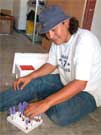By ELIZABETH PISANI
631 words
21 March 1996
<
Asia Times
English
(c) 1996 Chamber World Network International Ltd
Cambodia's garment industry - practically the country's only industry - is trying to convince Fortress Europe to bend the rules on clothing imports. The country claims it is simply too impoverished to benefit from rules designed to help poor countries sell into Europe's rich markets.
Cambodia is lobbying to be allowed to export garments under the European Union's Generalized System of Preferences (GSP) umbrella, which would free them of import duties. GSP is designed to help poor countries compete in the international world trade arena.
Cambodia says it cannot afford the investment needed to play by the rules. It is not enough for garments to be cut and stitched together in Cambodia - Euro-pean rules stipulate that the cloth must be made in the country too.
Although Cambodia did once have two factories spinning and weaving cotton, they ground to a halt following the upheavals of the past two decades. Time has turned most of the machinery into museum pieces and now the country produces no textiles at all.
A Taiwanese company has plans to revamp one of the factories, but it will be years before the country can produce the cloth it needs to feed its rapidly growing army of seamstresses. "Textile factories require a huge amount of capital. Cambodia is still a very high risk investment and I don't think anyone wants to put money into a mega-project like that," said Danny Wong of the Loyal Cambodia garment factory.
Textiles aside, many believe the real fly in the ointment is the fact that there is no quota on Cambodian garment imports to Europe. This has led to a rash of fake documents certifying that clothes are made in Cambodia when in fact they come from manufacturers in other countries who are trying to escape quota restrictions. "We know of 1,700-plus falsified certificates since 1993, compared with 1,400 real ones," said a senior Commerce Ministry official.
An 11-member delegation from the European Union is due to end a visit to Phnom Penh on Thursday without having announced whether garments imported from Cambodia would qualify for GSP import duties. Only Lesotho is excused from having to make its own textiles.
The delegation itself was tight-lipped about what it would recommend to Brussels, but manufacturers are optimistic. "I think they will understand that Cambodia is a poor country and do what they can to help," said a manager at Cambodia Garments, a Malaysian-owned factory that is Cambodia's biggest exporter of clothing.
Access to European markets is life or death to the Cambodian garment industry. The country does not have Most Favored Nation (MFN) status with the United States, which means importers must pay a whopping 45 percent duty on most items. "We can't possibly compete in the US now. MFN would make all the difference," said a factory manager.
Even with the door to the world's most important market firmly shut, Cambodia's garment industry has flowered in the short years since relative peace was restored. In 1994, nine garment factories exported US$3.4 million worth of clothes. In 1995, the figure shot up nearly eight-fold, to US$26.5 million, from 17 factories.
Now there are 19 factories employing nearly 10,000 people, and still they mushroom. Co-Prime Minister Hun Sen said he had approved another 20 or so factories. "That will put prices up. We have a real shortage of skilled labor and these new factories always want to steal staff by offering higher salaries," said Loyal's Wong. "As soon as they sign MFN, then all the factories will go into full swing."
Copyright 1996 Asia Times.
(c) 1996 Chamber World Network International Ltd.




